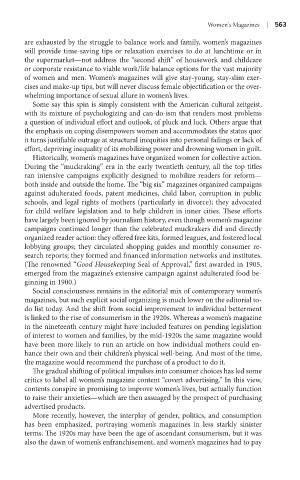Page 584 - Battleground The Media Volume 1 and 2
P. 584
Women’s Magaz nes |
are exhausted by the struggle to balance work and family, women’s magazines
will provide time-saving tips or relaxation exercises to do at lunchtime or in
the supermarket—not address the “second shift” of housework and childcare
or corporate resistance to viable work/life balance options for the vast majority
of women and men. Women’s magazines will give stay-young, stay-slim exer-
cises and make-up tips, but will never discuss female objectification or the over-
whelming importance of sexual allure in women’s lives.
Some say this spin is simply consistent with the American cultural zeitgeist,
with its mixture of psychologizing and can-do-ism that renders most problems
a question of individual effort and outlook, of pluck and luck. Others argue that
the emphasis on coping disempowers women and accommodates the status quo:
it turns justifiable outrage at structural inequities into personal failings or lack of
effort, depriving inequality of its mobilizing power and drowning women in guilt.
Historically, women’s magazines have organized women for collective action.
During the “muckraking” era in the early twentieth century, all the top titles
ran intensive campaigns explicitly designed to mobilize readers for reform—
both inside and outside the home. The “big six” magazines organized campaigns
against adulterated foods, patent medicines, child labor, corruption in public
schools, and legal rights of mothers (particularly in divorce); they advocated
for child welfare legislation and to help children in inner cities. These efforts
have largely been ignored by journalism history, even though women’s magazine
campaigns continued longer than the celebrated muckrakers did and directly
organized reader action: they offered free kits, formed leagues, and fostered local
lobbying groups; they circulated shopping guides and monthly consumer re-
search reports; they formed and financed information networks and institutes.
(The renowned “Good Housekeeping Seal of Approval,” first awarded in 1905,
emerged from the magazine’s extensive campaign against adulterated food be-
ginning in 1900.)
Social consciousness remains in the editorial mix of contemporary women’s
magazines, but such explicit social organizing is much lower on the editorial to-
do list today. And the shift from social improvement to individual betterment
is linked to the rise of consumerism in the 1920s. Whereas a women’s magazine
in the nineteenth century might have included features on pending legislation
of interest to women and families, by the mid-1920s the same magazine would
have been more likely to run an article on how individual mothers could en-
hance their own and their children’s physical well-being. And most of the time,
the magazine would recommend the purchase of a product to do it.
The gradual shifting of political impulses into consumer choices has led some
critics to label all women’s magazine content “covert advertising.” In this view,
contents conspire in promising to improve women’s lives, but actually function
to raise their anxieties—which are then assuaged by the prospect of purchasing
advertised products.
More recently, however, the interplay of gender, politics, and consumption
has been emphasized, portraying women’s magazines in less starkly sinister
terms. The 1920s may have been the age of ascendant consumerism, but it was
also the dawn of women’s enfranchisement, and women’s magazines had to pay

